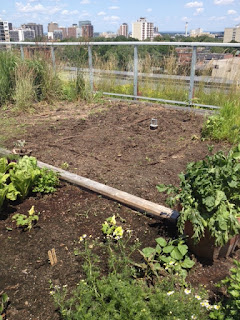Since the plants arrived at noon on the hottest day of the summer, we waited until 5 pm to put them in the ground. We decided to plant only where we could work in the shade, which meant that the compost "field" got planted. There is a plantain path behind the planters, in front of the composter, and to the composter. The rest is mainly wild violets!
 |
| Compost Field |
 |
| The Wilderness |
We had some plants left. The plantain path behind the planters in the wilderness behind plots 6-9 was started, with a voilet patch and some oregano in the rest.
I drew out a keyhole pattern in the wilderness that stretches around the roof anchor, figuring that maintenance should have easy access to it. The keyhole itself will be a plantain patch; it will also be much easier to tend to the plants around it.




